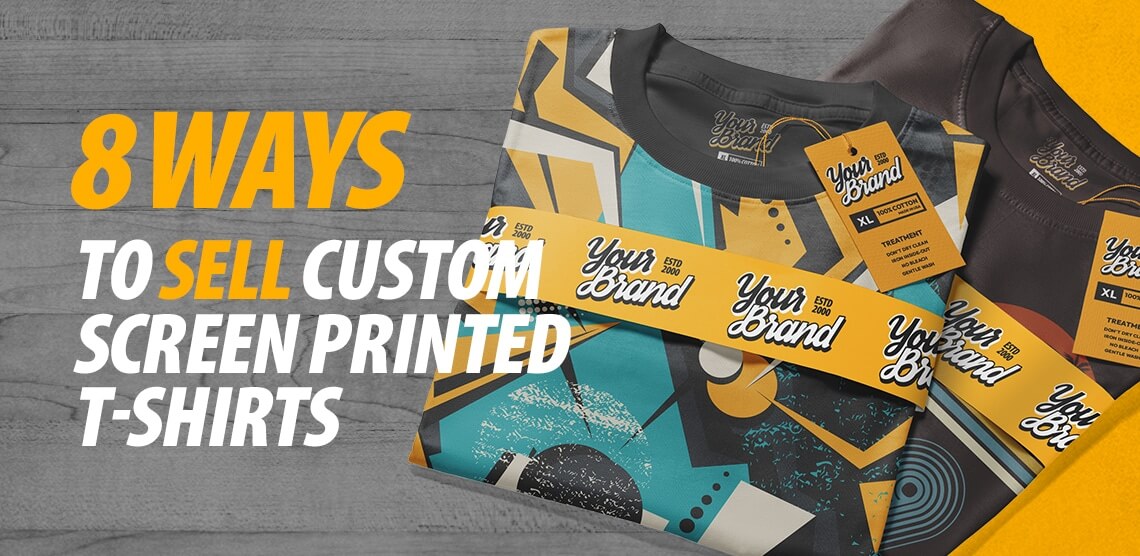Detailed Silk Screen Printing for Custom Art Apparel
Wiki Article
Screen Printing Uncovered: Every Little Thing You Need to Learn About Tee and Garment Printing Techniques
Screen printing is a remarkable approach that combines art with technique, offering countless possibilities for creative thinking. All set to discover the vital elements that make screen publishing an art form?
The Basics of Display Printing: How It Works
When you plunge into display printing, you'll uncover it's both an art and a scientific research. At its core, screen printing entails producing a stencil, or display, that enables ink to pass with only in particular areas.Next, you'll mix your inks and prepare your printing surface. Position the screen over the textile, after that use a squeegee to push ink through the screen onto the garment. This procedure requires precision, as you desire clear, dynamic prints. After printing, you'll cure the ink with warm, ensuring it sticks to the textile and lasts via washes. Each action is necessary, and mastering them will raise your display printing skills, transforming basic garments right into unique, expressive items.
Sorts Of Display Printing Methods
As soon as you grasp the essentials of screen printing, it's time to check out the various strategies that can raise your designs. One preferred approach is traditional screen printing, where ink is pushed with a stenciled screen. This technique is fantastic for vibrant, vivid shades. After that there's water-based ink printing, which offers a softer feeling and is green, but it needs a various method to curing.If you're going for fine details, take into consideration discharge printing. This method removes dye from the fabric, leaving a soft, vintage appearance. An additional choice is plastisol printing, known for its durability and brilliant colors, making it a favored for lots of brands. Ultimately, try out halftone printing to produce slope results and intricate designs. Each technique has its unique appeal, so don't hesitate to attempt them bent on find what fits your style best!
Crucial Tools for Screen Printing
To achieve stunning results in screen printing, having the appropriate devices is fundamental. You'll require a sturdy screen printing frame, which holds the mesh that transfers your design onto the garment. Next, invest in top quality mops; these are essential for using ink uniformly across the screen.Selecting the Right Inks and Products
When picking inks and products for display printing, you require to consider the kind of ink that works finest for your task. Think of textile compatibility to assure your designs look last and excellent long. Additionally, check out environment-friendly ink options to make your printing process much more lasting.Kinds Of Screen Inks
Choosing the right screen ink is essential for accomplishing vivid, durable prints that fulfill your job's needs. There are numerous types of display inks to analyze. Specialty inks, such as metal or glow-in-the-dark, can include one-of-a-kind effects to your layouts.
Textile Compatibility Factors To Consider
Understanding material compatibility is important for attaining high-grade display prints, especially since various products respond distinctly to numerous inks. Always examine your inks on sample fabric to assure they stick correctly and keep color stability. Furthermore, maintain in mind that textile weight and texture can affect the final end result, so picking the appropriate ink and product combo is vital for your project's success.Eco-Friendly Ink Options
Eco-friendly inks are coming to be a preferred option for display printers that want to minimize their ecological influence while keeping high quality. When choosing inks, take into consideration water-based inks, which are much less harmful and less complicated to cleanse up contrasted to standard solvents.In addition, look for inks made from renewable energies, such as soy or vegetable-based choices. By selecting the appropriate inks and products, you'll not only create stunning designs yet also add to an extra sustainable printing procedure. Make the switch, and your prints will mirror your dedication to the environment!
Preparing Your Layout for Display Printing

File Style Requirements
To assure your style looks sharp and vivid on material, you'll require to pay very close attention to submit format requirements for display printing. Start with vector documents like AI or EPS, as they can be scaled without shedding high quality. If you use raster pictures, go with high-resolution data, such as TIFF or PNG, preferably at 300 DPI. Prevent making use of JPEGs, as they can lose clearness when resized. Likewise, ensure your layout has a transparent history to avoid undesirable white sides on your prints. Keep color modes in mind; CMYK is common for screen printing, so convert your RGB makes appropriately - screen printing kit. By adhering to these standards, you'll set your art work up for a successful print.Shade Splitting Up Techniques
Shade splitting up is a vital step in preparing your layout for display printing, and mastering it can considerably boost your print quality. You'll need to break your style into private colors, as each color requires a separate display during printing. This precision not only ensures exact shade representation however additionally enhances the printing procedure.Resolution and Size
Attaining the most effective cause display printing begins with assuring your design has the right resolution and dimension. Preferably, your art work must go to the very least 300 DPI (dots per inch) for sharp, clear prints. Your last item might look less than professional and pixelated. if you make use of reduced resolution.When it concerns dimension, consider the measurements of your print area. Style your art work to match the last print dimension, ideally developing it in the actual measurements you'll be printing. This means, you'll avoid any type of unanticipated scaling problems.
Constantly inspect your style in both vector and raster styles. Vector graphics can be scaled without shedding top quality, making them ideal for display printing. Preparing appropriately will guarantee your design looks amazing on every garment!
Step-by-Step Screen Printing Process
Display printing is a dynamic process that permits you to develop lively designs on different surfaces. To begin, you'll need a screen, emulsion, and your selected ink. Prepare your display by cleansing it extensively. Next off, use the solution equally and let it completely dry in a dark location. Once dry, subject your screen to light with your design put on it, which will harden the emulsion where the light hits, developing a stencil - screen printing kit.After cleaning out the unexposed emulsion, your screen is prepared. Set it up on your printing surface and straighten your garment under it. Pour ink onto the display and use a squeegee to press the ink with the stencil onto the textile. Lift the screen carefully and allow the print completely dry. Treat the ink utilizing warm to assure toughness. That's it! You have actually successfully screen published your design.
Tips for Effective Display Printing Projects
While you're diving into your display printing jobs, keep in mind that prep work is key to success. Beginning by gathering all your materials-- inks, garments, displays, and squeegees. A tidy work area assists protect against unwanted mistakes, so clean before you begin.Following, confirm your artwork is high-resolution and appropriately sized for your garment. Examine your display for correct direct exposure and clean garment printing it thoroughly to prevent smudges. When blending your inks, follow the manufacturer's guidelines to achieve the best uniformity.
Throughout printing, apply even pressure with your squeegee for consistent results. Do not hurry; take your time to verify each print fulfills your standards. After printing, allow your garments completely dry entirely before handling or packaging them.
Last but not least, constantly keep an example of your work for future reference. This means, you can analyze your progress and improve your strategies over time. Happy printing!

Frequently Asked Questions
For how long Does It Require To Establish a Display Printing Job?
Establishing up a display printing job usually takes around thirty minutes to an hour. You'll prepare the screens, mix inks, and change the press. The time differs based on intricacy and experience, so stay organized!Can I Publish on Various Textile Keys In Utilizing the Very Same Strategy?
Yes, you can publish on different material kinds using the exact same method, yet you'll need to adjust your inks and settings. Some textiles absorb ink in different ways, so exploring guarantees the ideal outcomes for each and every material.What Prevail Blunders to Avoid in Display Printing?
When screen printing, stay clear of typical blunders like making use of the wrong ink, neglecting proper direct exposure times, or missing pre-press checks. Constantly test your setup and preserve clean screens to ensure top quality results each time.Exactly How Can I Correctly Tidy and Preserve My Screen Printing Equipment?
To appropriately clean and preserve your display printing devices, you ought to frequently wash screens with suitable solvents, examine mops for wear, and assure all devices are stored dust-free and dry. Uniformity enhances and prevents costly repair services performance.Is Screen Printing Environmentally Friendly Contrasted to Other Techniques?
Screen printing can be more eco friendly than various other approaches, specifically if you make use of eco-conscious materials and water-based inks. By selecting lasting supplies and methods, you reduce waste and decrease your influence on the earth.Display Printing Uncovered: Whatever You Need to Know About Tee and Garment Printing Methods
At its core, screen printing involves producing a stencil, or screen, that allows ink to pass via just in certain areas. Setting the screen over the textile, after that utilize a squeegee to push ink with the screen onto the garment. One preferred approach is traditional display printing, where ink is pushed with a stenciled display.When selecting inks and materials for display printing, you need to take right into account the kind of ink that works best for your project.
Report this wiki page